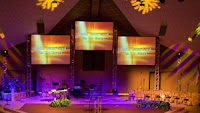 Have you ever sat in a church service and not been able to read the lyrics on the screen? Or have you shown a movie on a projector only to be disappointed by the quality? There are many different elements to consider when purchasing a projector. In this blog, we’ll look at brightness and contrast ratio and how they affect the quality of the projected image.
Have you ever sat in a church service and not been able to read the lyrics on the screen? Or have you shown a movie on a projector only to be disappointed by the quality? There are many different elements to consider when purchasing a projector. In this blog, we’ll look at brightness and contrast ratio and how they affect the quality of the projected image.Let's look at contrast ratio first. We know that a ratio is a comparison between two quantities or values. Contrast ratio is the ratio of light to dark, or the number of shades of gray between white and black. If a projector claims to have a contrast ratio of 500:1, that projector uses 500 shades to define the difference between white and black. Obviously, the higher the contrast ratio number, the better the image. Typically, projectors with high contrast ratios have been geared toward home theater applications. This is because a higher contrast ration will produce a higher degree of image detail which is most noticeable in recorded or live video images. I've seen movies, such as Lord of the Rings or The Passion of the Christ, shown on brighter projectors with a low contrast ratio. While the image was nice and bright, there wasn’t enough detail in the darker sequences which made the projector seem to struggle to project the image.
Now, let's talk about brightness. The American National Standards Institute or ANSI is an organization that oversees product standards in the United States. This organization developed a standard by which the brightness of a projector should be measured and marketed, which involves averaging several measurements taken at various positions. This has been the standard for choosing projectors for many years and is still the means by which most projectors are purchased today. A lumen is a unit of luminous flux, which is the measure of perceived power of light energy. As is the case of contrast ratio, the higher the ANSI lumen number, the better or brighter the image. As moving images become more popular in backgrounds for worship, a bright projector is critical for displaying words (such as song lyrics or scriptures) that the audience can read.
So, which specification is more important, brightness or contrast ratio? Well, that depends on your application and budget. There's no question that we're seeing projectors today that are brighter and less expensive than we could have imagined five years ago. And now, some of those projectors have contrast ratios up to 10,000:1.
If you are in the market for a new projector, ask yourself (and your team) three questions:
- What's the budget?
- What's the purpose?
- Where's it going?
This is the first in a series of blogs that will cover the different aspects of choosing the projector that is right for you.





No comments:
Post a Comment